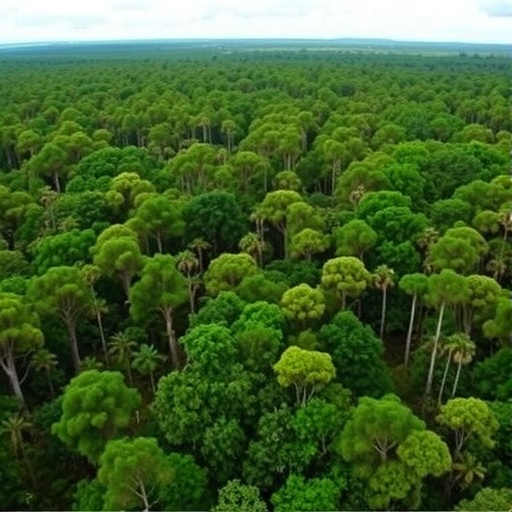In a groundbreaking new study published in Nature, researchers have unveiled a sobering shift in the carbon dynamics of Australian tropical forests. Long considered critical carbon sinks that mitigate climate change effects, these forests have transitioned over recent decades into net carbon sources. This shift calls into question prevailing assumptions about tropical forest resilience and carbon sequestration under future climate scenarios.
Tropical forests have historically been integral to the global carbon cycle, acting as vast reservoirs that absorb atmospheric CO₂ through photosynthesis and store it in biomass. Earth System Models (ESMs), which are foundational tools for climate prediction, have long forecasted that rising atmospheric CO₂ concentrations will stimulate tree growth, enhancing this carbon sink effect. However, mounting empirical evidence from forest inventory analyses worldwide has painted a contrasting picture, signaling a decline in carbon sink capacity and raising concerns about potential ecosystem shifts from carbon sinks to carbon sources.
The recent study focuses on detailed long-term data spanning nearly five decades—1,048 forest inventory censuses from 1971 to 2019—collected across Australian moist tropical forests. Utilizing a rigorous causal inference framework, the researchers quantified aboveground woody biomass carbon balance and dissected the demographic drivers affecting forest carbon stocks. Their analysis reveals that the net carbon sink observed during the 1970s through the 1990s, averaging 0.62 megagrams of carbon per hectare per year, steadily eroded, culminating in a net carbon source status by 2010–2019, with losses reaching −0.93 megagrams of carbon per hectare annually.
This transition from sink to source signifies a critical inflection point in forest carbon dynamics, with the sink capacity declining by approximately 0.041 megagrams of carbon per hectare per year. The authors implicate increasing climate anomalies—chiefly extreme temperature events and prolonged drought stress—as potent stressors elevating tree mortality rates and biomass losses. These climatic pressures, exacerbated by global warming, challenge forest resilience and reduce the capacity for carbon accumulation.
Remarkably, contrary to model-based expectations of carbon fertilization, the study found no empirical evidence indicating enhanced woody tree growth amidst elevated atmospheric CO₂ levels or contemporaneous climatic conditions. This finding suggests that the predicted stimulatory effects of CO₂ on biomass accumulation may be overshadowed or negated by climate-induced physiological stresses and mortality.
Crucially, the study also emphasized the influence of tropical cyclones as episodic yet significant drivers of biomass fluctuations. The damage inflicted by cyclone events mirrored the magnitude of long-term climatic impacts, inflicting abrupt reductions in aboveground biomass and catalyzing shifts in forest demographic structure. These disturbances punctuated the steady decline driven by chronic climatic stress, further destabilizing the carbon balance.
The implications of this research extend beyond the Australian tropics. Given the ecological and climatic parallels, other moist tropical forests worldwide may be undergoing similar transitions, which could profoundly affect the global carbon budget. The potential for tropical forests to shift to net carbon sources presents a feedback loop that could accelerate climate change by releasing stored carbon, thereby exacerbating atmospheric greenhouse gas concentrations.
This study underscores the urgency of revising Earth System Models to integrate observed forest responses to climate stressors more accurately. Enhanced representation of tree mortality, disturbance regimes, and climatic extremes is essential for realistic forecasting of tropical forest carbon dynamics and global climate feedbacks. Additionally, the lack of detectable carbon fertilization effects calls for cautious interpretation of CO₂-driven growth hypotheses.
The methodologies employed—combining exhaustive forest inventory data with advanced causal inference modeling—represent a vital advancement in understanding ecosystem-climate interactions. They allow disentangling of complex cause-effect relationships in observational ecological data, providing a clearer picture of the drivers underlying carbon flux changes.
Not only does this research provide a clarion call about tropical forest vulnerabilities, but it also highlights the need for comprehensive conservation and climate mitigation strategies targeting these ecosystems. Protecting tropical forests from compounded climatic and disturbance pressures could help maintain their critical function in carbon sequestration and global climate regulation.
As global temperatures continue to rise and extreme weather events intensify, ongoing monitoring and adaptive management of tropical forests become indispensable. This study supplies vital empirical benchmarks to inform policy and guide interventions aimed at safeguarding forest carbon stocks amidst a rapidly changing climate.
In sum, the findings documented by Carle et al. mark a paradigm shift in our understanding of tropical forest carbon dynamics, revealing a precarious trend with profound implications for climate change mitigation efforts. The transition of Australian tropical forests from carbon sinks to sources illustrates that the ecological balance supporting carbon sequestration is far more fragile and susceptible to climatic disturbances than previously appreciated.
Subject of Research:
Carbon balance dynamics and climatic drivers of aboveground biomass in Australian tropical forests.
Article Title:
Aboveground biomass in Australian tropical forests now a net carbon source.
Article References:
Carle, H., Bauman, D., Evans, M.N. et al. Aboveground biomass in Australian tropical forests now a net carbon source. Nature 646, 611–618 (2025). https://doi.org/10.1038/s41586-025-09497-8
DOI:
https://doi.org/10.1038/s41586-025-09497-8
Tags: atmospheric CO₂ absorptionAustralian tropical forestsbiomass carbon balancecarbon dynamics shiftcarbon sequestration resiliencecarbon sink to source transitionClimate Change Impactclimate prediction challengesEarth System Modelsecosystem carbon stocksforest inventory analysislong-term ecological data





